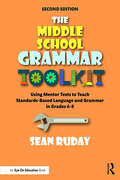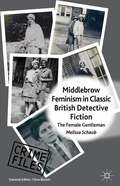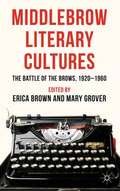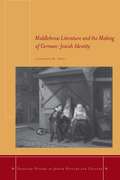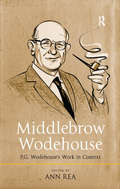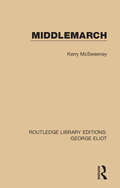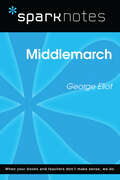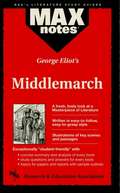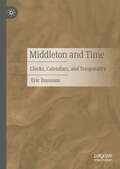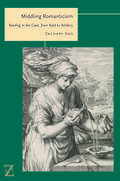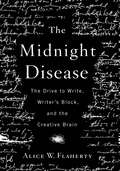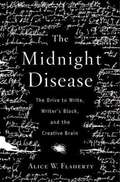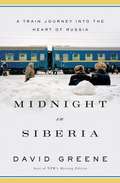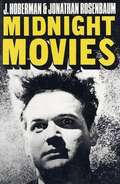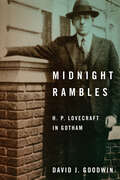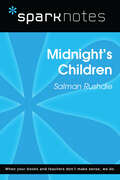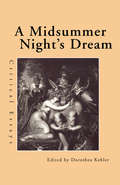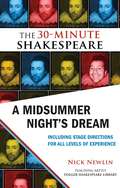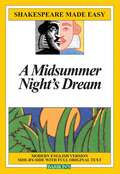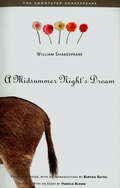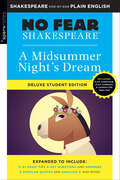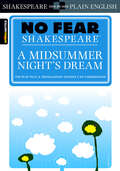- Table View
- List View
The Middle School Grammar Toolkit: Using Mentor Texts to Teach Standards-Based Language and Grammar in Grades 6–8
by Sean RudayTeaching grammar can be overwhelming and is often an overlooked part of effective instruction. The Middle School Grammar Toolkit to the rescue! Now in its second edition, this comprehensive guide makes grammar instruction fun and meaningful. You will learn how to: Teach grammar in a practical and applicable way by presenting each grammar rule as a useful writing tool for students. Use mentor texts—excerpts from great literature—to help students understand grammar in action. Promote metacognition along the way, so that students become responsible for their own learning. Implement innovative instructional strategies and tools aligned with Common Core and other state standards. Throughout the book, you’ll find step-by-step recommendations for teaching grammatical concepts, such as understanding intensive pronouns, choosing language that expresses ideas precisely, forming verbs in different moods, and maintaining consistency in style and tone, and much, much more. Organized to help students meet the Common Core State Standards and other state language standards for Grades 6–8, the book includes tips addressing teaching for each of these grades, classroom snapshots that show you the tools in action, and specific instructional recommendations to engage students. New! The second edition features revised classroom snapshots and exemplars to showcase successful practices, and new flowcharts to visually represent instructional recommendations. The expanded, free annotated bibliography is updated to include contemporary, high-quality young adult literature and gives examples of key grammatical concepts found in each work. These resources are available as Supplemental Downloads on our website.
Middlebrow Feminism in Classic British Detective Fiction
by Melissa SchaubThis is a feminist study of a recurring character type in classic British detective fiction by women - a woman who behaves like a Victorian gentleman. Exploring this character type leads to a new evaluation of the politics of classic detective fiction and the middlebrow novel as a whole.
Middlebrow Literary Cultures
by Erica Brown Mary GroverThis collection of essays demonstrates that the middlebrow matters. This literary 'middle ground', once dismissed by academia as insignificant and uninteresting, is the site of powerful anxieties about cultural authority that continue to this day. These essays examine the prejudices and aspirations at work in the 'battle of the brows', and show that the middlebrow is central to our understanding of the literary landscape as a whole. Rather than being a stable, easily identifiable mass, the meaning of the middlebrow changes with historical, geographical and formal context. The introduction to this collection traces the complex development of the term, and offers a timely overview of the critical literature. Contributors include Nicola Humble, author of The Feminine Middlebrow Novel, and Joan Rubin, author of The Making of Middlebrow Culture.
Middlebrow Literature and the Making of German-Jewish Identity
by Jonathan M. HessHistorians have had a much easier time of documenting German Jews' consumption of German high culture than recognizing the significance of the newspapers, periodicals, and book series that German-Jewish print media published from the 1830s on, according to Hess (Germanic languages and literatures/Jewish studies, U. of North Carolina at Chapel Hill). While such middlebrow literature lacked the prestige of Goethe and Schiller and is largely forgotten today, it represented the emergence of a solid literary tradition in its own right that influenced Jewish- German middle-class identity and contemporary Jewish voices. He traces the history and role of such belles lettres by genre, e. g, the Allgemeine Zeitung des Judentums (Universal Jewish Newspaper), historical fiction, and romance. The book includes several art illustrations. Annotation ©2010 Book News, Inc. , Portland, OR (booknews. com)
Middlebrow Queer: Christopher Isherwood in America
by Jaime HarkerHow could one write about gay life for the mainstream public in Cold War America? Many midcentury gay American writers, hampered by external and internal censors, never managed to do it. But Christopher Isherwood did, and what makes his accomplishment more remarkable is that while he was negotiating his identity as a gay writer, he was reinventing himself as an American one. Jaime Harker shows that Isherwood refashioned himself as an American writer following his emigration from England by immersing himself in the gay reading, writing, and publishing communities in Cold War America. Drawing extensively on Isherwood&’s archives, including manuscript drafts and unpublished correspondence with readers, publishers, and other writers, Middlebrow Queer demonstrates how Isherwood mainstreamed gay content for heterosexual readers in his postwar novels while also covertly writing for gay audiences and encouraging a symbiotic relationship between writer and reader. The result—in such novels as The World in the Evening, Down There on a Visit, A Single Man, and A Meeting by the River—was a complex, layered form of writing that Harker calls &“middlebrow camp,&” a mode that extended the boundaries of both gay and middlebrow fiction.Weaving together biography, history, and literary criticism, Middlebrow Queer traces the continuous evolution of Isherwood&’s simultaneously queer and American postwar authorial identity. In doing so, the book illuminates many aspects of Cold War America&’s gay print cultures, from gay protest novels to &“out&” pulp fiction.
Middlebrow Wodehouse: P.G. Wodehouse's Work in Context
by Ann ReaWhile he is best known for his Jeeves and Bertie Wooster stories, P.G. Wodehouse was a prolific writer who penned many other novels, stories, and musical comedy libretti, the latter of which played an enormous role in the development of American musical theater. This collection re-examines Wodehouse in the context of recent scholarship on the middlebrow, attending to his self-conscious relationship to the literary marketplace and his role in moving musical comedy away from vaudeville’s lowbrow associations towards the sophistication of the Wodehouse style. The focus on the middlebrow creates a critical context for serious critical consideration of Wodehouse’s linguistic playfulness and his depictions of social class within England. The contributors explore Wodehouse’s fiction and libretti in reference to philosophy, depictions of masculinity, World War I Britain, the periodical market, ideas of Englishness, and cultural phenomena such as men’s fashion, food culture, and popular songwriting. Taken together, the essays draw attention to the arbitrary divide between high- and middlebrow culture and make a case for Wodehouse as a writer whose games with language are in keeping with modernist experimentation with artistic expression.
Middlemarch (Routledge Library Editions: George Eliot #5)
by Kerry McSweeneyFirst published in 1984. Although Middlemarch was extravagantly praised by Henry James, Emily Dickinson and Virginia Woolf, it is only in the last few decades that the novel has been widely recognised as George Eliot’s finest work, one of the greatest English novels, and one of the classic texts of nineteenth-century fiction. The intellectual, religious and aesthetic background to Middlemarch are fully examined, with particular attention paid to Eliot’s key doctrines of fellow-feeling and the humanistic economy of salvation. Professor McSweeney also provides fresh and thought-provoking discussions of the role of the omniscient narrator, and of character and characterisation. This title will be of interest to students of literature.
Middlemarch (SparkNotes Literature Guide Series)
by SparkNotesMiddlemarch (SparkNotes Literature Guide) by George Eliot Making the reading experience fun! Created by Harvard students for students everywhere, SparkNotes is a new breed of study guide: smarter, better, faster. Geared to what today's students need to know, SparkNotes provides: *Chapter-by-chapter analysis *Explanations of key themes, motifs, and symbols *A review quiz and essay topicsLively and accessible, these guides are perfect for late-night studying and writing papers
Middlemarch (MAXNotes Literature Guides)
by Gail RaeREA's MAXnotes for George Eliot's Middlemarch MAXnotes offer a fresh look at masterpieces of literature, presented in a lively and interesting fashion. Written by literary experts who currently teach the subject, MAXnotes will enhance your understanding and enjoyment of the work. MAXnotes are designed to stimulate independent thought about the literary work by raising various issues and thought-provoking ideas and questions. MAXnotes cover the essentials of what one should know about each work, including an overall summary, character lists, an explanation and discussion of the plot, the work's historical context, illustrations to convey the mood of the work, and a biography of the author. Each chapter is individually summarized and analyzed, and has study questions and answers.
Middleton and Rowley
by David NicolCan the inadvertent clashes between collaborators produce more powerful effects than their concordances? For Thomas Middleton and William Rowley, the playwriting team best known for their tragedy The Changeling, disagreements and friction proved quite beneficial for their work.This first full-length study of Middleton and Rowley uses their plays to propose a new model for the study of collaborative authorship in early modern English drama. David Nicol highlights the diverse forms of collaborative relationships that factor into a play's meaning, including playwrights, actors, companies, playhouses, and patrons. This kaleidoscopic approach, which views the plays from all these perspectives, throws new light on the Middleton-Rowley oeuvre and on early modern dramatic collaboration as a whole.
Middleton and Time: Clocks, Calendars, and Temporality
by Eric DunnumA great deal has been written about early modern temporality, both by scholars of Renaissance drama and historians of chronometry. Much of the former has focused, unsurprisingly, on Shakespeare. This book seeks to broaden the discussion of temporality and the early modern stage by focusing on “our other Shakespeare” – Thomas Middleton, a writer preoccupied with issues of time, chronometry, and temporality. In this first book length study of Middleton’s portrayal of time, his representations of clocks and calendars are explored as a way of understanding early modern time consciousness. Middleton, more than any other playwright of his era, was aware of the alienating qualities of these chronometric devices and showed how the subject’s experience of time was influenced by them, while also demonstrating how choices in chronometry were influenced by gender, class and religious identity. As a result, his texts explore the complex intersections between sexuality, economic systems, and temporality in the early modern world.
Middling Romanticism: Reading in the Gaps, from Kant to Ashbery (Lit Z)
by Zachary SngRomanticism is often understood as an age of extremes, yet it also marks the birth of the modern medium in all senses of the word. Engaging with key texts of the romantic period, the book outlines a wide-reaching project to re-imagine the middle as a constitutive principle. Sng argues that Romanticism dislodges such terms as medium, moderation, and mediation from serving as mere self-evident tools that conduct from one pole to another. Instead, they offer a dwelling in and with the middle: an attention to intervals, interstices, and gaps that make these terms central to modern understandings of relation.
The Midnight Disease: The Drive to Write, Writer's Block, and the Creative Brain
by Alice W. Flaherty&“An original, fascinating, and beautifully written reckoning . . . of that great human passion: to write.&”—Kay Redfield Jamison, national bestselling author of An Unquiet Mind Why is it that some writers struggle for months to come up with the perfect sentence or phrase while others, hunched over a keyboard deep into the night, seem unable to stop writing? In The Midnight Disease, neurologist Alice W. Flaherty explores the mysteries of literary creativity: the drive to write, what sparks it, and what extinguishes it. She draws on intriguing examples from medical case studies and from the lives of writers, from Franz Kafka to Anne Lamott, from Sylvia Plath to Stephen King. Flaherty, who herself has grappled with episodes of compulsive writing and block, also offers a compelling personal account of her own experiences with these conditions. &“[Flaherty] is the real thing . . . and her writing magically transforms her own tragedies into something strange and whimsical almost, almost funny.&”—The Washington Post &“This is interesting, heated stuff.&”—San Francisco Chronicle &“Brilliant . . . [a] precious jewel of a book . . . that sparkles with some fresh insight or intriguing fact on practically every page.&”—Seattle Post-Intelligencer &“Flaherty mixes memoir, meditation, compendium and scholarly reportage in an odd but absorbing look at the neurological basis of writing and its pathologies . . . Writers will delight in the way information and lore are interspersed.&”—Publishers Weekly
The Midnight Disease: The Drive to Write, Writer's Block, and the Creative Brain
by Alice Weaver FlahertyNeurologist Flaherty (Massachusetts General Hospital and Harvard Medical School) explains the psychological and neuroscientific knowledge about the process of writing for a lay audience. She discusses the temporal lobe's role in "abnormal hypergraphia," an increased desire to write. She then explores psychological and neurological explanations for writer's block. The roles of the cerebral cortex in writing ability, the limbic system in the drive to communication, and the temporal lob in metaphorical thinking are examined in subsequent chapters. Annotation ©2004 Book News, Inc. , Portland, OR (booknews. com)
Midnight in Siberia: A Train Journey Into the Heart of Russia
by David GreeneFar away from the trendy cafés, designer boutiques, and political protests and crackdowns in Moscow, the real Russia exists. Midnight in Siberia chronicles David Greene's journey on the Trans-Siberian Railway, a 6,000-mile cross-country trip from Moscow to the Pacific port of Vladivostok. In quadruple-bunked cabins and stopover towns sprinkled across the country's snowy landscape, Greene speaks with ordinary Russians about how their lives have changed in the post-Soviet years. These travels offer a glimpse of the new Russia--a nation that boasts open elections and newfound prosperity but continues to endure oppression, corruption, a dwindling population, and stark inequality. We follow Greene as he finds opportunity and hardship embodied in his fellow train travelers and in conversations with residents of towns throughout Siberia. We meet Nadezhda, an entrepreneur who runs a small hotel in Ishim, fighting through corrupt layers of bureaucracy every day. Greene spends a joyous evening with a group of babushkas who made international headlines as runners-up at the Eurovision singing competition. They sing Beatles covers, alongside their traditional songs, finding that music and companionship can heal wounds from the past. In Novosibirsk, Greene has tea with Alexei, who runs the carpet company his mother began after the Soviet collapse and has mixed feelings about a government in which his family has done quite well. And in Chelyabinsk, a hunt for space debris after a meteorite landing leads Greene to a young man orphaned as a teenager, forced into military service, and now figuring out if any of his dreams are possible. Midnight in Siberia is a lively travel narrative filled with humor, adventure, and insight. It opens a window onto that country's complicated relationship with democracy and offers a rare look into the soul of twenty-first-century Russia.
Midnight Movies
by J. Hoberman Jonathan RosenbaumMidnight Movies is a comprehensive and in-depth look at over 100 subculture movies of the past three decades. It discusses the complete history of cult films, their makers, and their audience and what keeps audiences coming back to see them over and over again.
Midnight Rambles: H. P. Lovecraft in Gotham
by David J. GoodwinA micro-biography of horror fiction’s most influential author and his love–hate relationship with New York City.By the end of his life and near financial ruin, pulp horror writer Howard Phillips Lovecraft resigned himself to the likelihood that his writing would be forgotten. Today, Lovecraft stands alongside J. R. R. Tolkien as the most influential genre writer of the twentieth century. His reputation as an unreformed racist and bigot, however, leaves readers to grapple with his legacy. Midnight Rambles explores Lovecraft’s time in New York City, a crucial yet often overlooked chapter in his life that shaped his literary career and the inextricable racism in his work. Initially, New York stood as a place of liberation for Lovecraft. During the brief period between 1924 and 1926 when he lived there, Lovecraft joined a creative community and experimented with bohemian living in the publishing and cultural capital of the United States. He also married fellow writer Sonia H. Greene, a Ukrainian-Jewish émigré in the fashion industry. However, cascading personal setbacks and his own professional ineptitude soured him on New York. As Lovecraft became more frustrated, his xenophobia and racism became more pronounced. New York’s large immigrant population and minority communities disgusted him, and this mindset soon became evident in his writing. Many of his stories from this era are infused with racial and ethnic stereotypes and nativist themes, most notably his overtly racist short story, “The Horror at Red Hook,” set in Red Hook, Brooklyn. His personal letters reveal an even darker bigotry.Author David J. Goodwin presents a chronological micro-biography of Lovecraft’s New York years, emphasizing Lovecraft’s exploration of the city environment, the greater metropolitan region, and other locales and how they molded him as a writer and as an individual. Drawing from primary sources (letters, memoirs, and published personal reflections) and secondary sources (biographies and scholarship), Midnight Rambles develops a portrait of a talented and troubled author and offers insights into his unsettling beliefs on race, ethnicity, and immigration.
Midnight's Children (SparkNotes Literature Guide Series)
by SparkNotesMidnight's Children (SparkNotes Literature Guide) by Salman Rushdie Making the reading experience fun! Created by Harvard students for students everywhere, SparkNotes is a new breed of study guide: smarter, better, faster. Geared to what today's students need to know, SparkNotes provides: *Chapter-by-chapter analysis *Explanations of key themes, motifs, and symbols *A review quiz and essay topicsLively and accessible, these guides are perfect for late-night studying and writing papers
A Midsummer Night's Dream: Critical Essays (Shakespeare Criticism #19)
by Dorothea KehlerThis volume traces the modern critical and performance history of this play, one of Shakespeare's most-loved and most-performed comedies. The essay focus on such modern concerns as feminism, deconstruction, textual theory, and queer theory.
A Midsummer Night's Dream: The 30-Minute Shakespeare
by Nick NewlinPlanning a school or amateur Shakespeare production? The best way to experience the plays is to perform them, but getting started can be a challenge: The complete plays are too long and complex, while scene selections or simplified language are too limited."The 30-Minute Shakespeare" is a new series of abridgements that tell the "story" of each play from start to finish while keeping the beauty of Shakespeare's language intact. Specific stage directions and character suggestions give even inexperienced actors the tools to perform Shakespeare with confidence, understanding, and fun!This cutting focuses on three ridiculously funny and vibrant scenes from A MIDSUMMER NIGHT'S DREAM. The first scene starts with Puck mistakenly anointing the eyes of the wrong lovers with love potion, leading to a madcap chase scene between Helena, Lysander, Hermia, and Demetrius. Scene two features Bottom's magical transformation to an ass, always an audience favorite. The final scene is the classic play within a play, where the "Rude Mechanicals" act out with "tragical mirth" the story of Pyramus and Thisbe, with specific comic suggestions for the characters, including Lion chasing Thisbe into the audience!The edition also includes an essay by editor Nick Newlin on how to produce a Shakespeare play with novice actors, and notes about the original production of this abridgement at the Folger Shakespeare Library's annual Student Shakespeare Festival.
Midsummer Night's Dream (Shakespeare Made Easy)
by William ShakespeareA Simon & Schuster eBook. Simon & Schuster has a great book for every reader.
A Midsummer Night's Dream
by William ShakespeareFrom the hilarious mischief of the elf Puck to the rough humor of the self-centered Bottom and his fellow players, from the palace of Theseus in Athens to the magic wood where fairies play, Shakespeare's marvelous A Midsummer Night's Dream is a play of enchantment and an insightful portrait of the predicaments of love.
A Midsummer Night's Dream
by William Shakespeare Mcdougal-Littell Publishing StaffShakespeare's comedy of lovers in the forest, with additional readings and supporting materials.
A Midsummer Night's Dream: No Fear Shakespeare Deluxe Student Editions - Shakespeare Side-by-Side Plain English (No Fear Shakespeare)
by William Shakespeare SparkNotesShakespeare everyone can understand—now in this new EXPANDED edition of MIDSUMMER NIGHT&’S DREAM! Why fear Shakespeare? By placing the words of the original play next to line-by-line translations in plain English, this popular guide makes Shakespeare accessible to everyone. And now it features expanded literature guide sections that help students study smarter. The expanded sections include: Five Key Questions: Five frequently asked questions about major moments and characters in the play. What Does the Ending Mean?: Is the ending sad, celebratory, ironic . . . or ambivalent? Plot Analysis: What is the play about? How is the story told, and what are the main themes? Why do the characters behave as they do? Study Questions: Questions that guide students as they study for a test or write a paper. Quotes by Theme: Quotes organized by Shakespeare&’s main themes, such as love, death, tyranny, honor, and fate. Quotes by Character: Quotes organized by the play&’s main characters, along with interpretations of their meaning.
A Midsummer Night's Dream: No Fear Shakespeare Side-by-Side Plain English (No Fear Shakespeare)
by William Shakespeare SparkNotesThis No Fear Shakespeare ebook gives you the complete text of A Midsummer Night's Dreamand an easy-to-understand translation.Each No Fear Shakespeare containsThe complete text of the original playA line-by-line translation that puts Shakespeare into everyday languageA complete list of characters with descriptionsPlenty of helpful commentary
